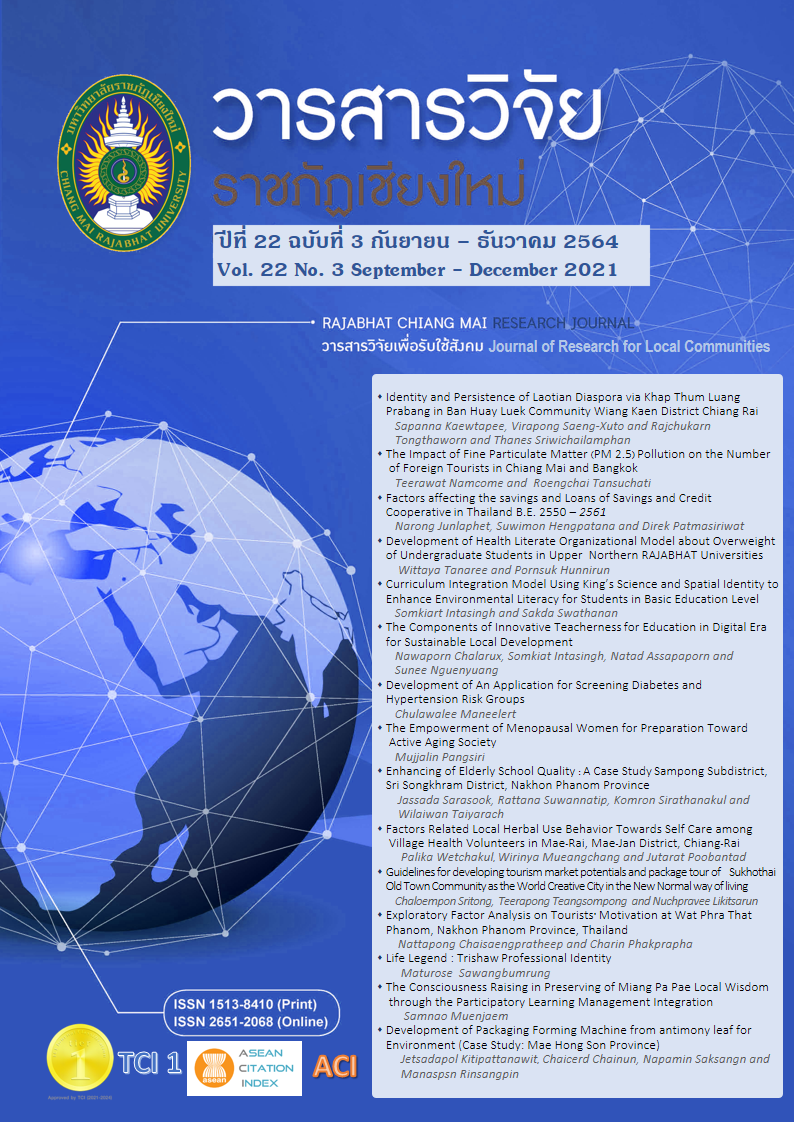Guidelines for Developing Tourism Market Potentials and Package Tour of Sukhothai Old Town Community as the World Creative City in the New Normal Way of Living
DOI:
https://doi.org/10.14456/rcmrj.2021.245731Keywords:
Market development, Community-based tourism, The world creative city, The new normal way of livingAbstract
This article aimed to study 1) the community contexts, 2) the market potentials and the guidelines for developing marketing potentials, and 3) the package tour of Sukhothai Old Town Community as the World Creative City of Thailand in the New Normal way of living. This qualitative approach used an in-depth interview, informal interview, and participant observation from 27 key informants (i.e., community leaders, government representatives, and tourism entrepreneurs in Sukhothai province) chosen by purposive and snowball sampling. All data were analyzed using content analysis. The findings showed that 1) the Sukhothai Old Town Community was established surrounding the Sukhothai Historical Park. The community comprises 12 smaller communities, all of which generate tourism products linking to the major tourist attractions. 2) The community has outstanding tourism products because of its long-standing cultural heritage, for example, chinaware, Khao Tok Pra Ruang (literally “popped rice of Phra Ruang”), Lao Puan Traditional Clothing, and the Bai Si ceremony (The ceremony of welcome). Besides, the community has developed the guidelines for tourism, for example, the package tour based on tourist’s behaviours and individual interests, the creation of identity products for Sukhothai Old Town, the upgrading of the Safety and Health Administration (SHA) in the New Normal way of living among community tourism entrepreneurs. 3) The development of a 3-day and 2-night package tour of Yon Moradok Phra Ruang (literally
“The appreciation of Moradok Phra Ruang”) is initiated by the community in collaboration with the Thai Federation of Provincial Tourist Association for tourism market promotion.
Downloads
References
Anantamongkolkul, C. & Pattanapokinsakul, K. (2019). Creative Tourism Behaviour of Cultural Tourists in Phuket. Journal of International and Thai Tourism, 15(2), 1-20. https://so02.tci-thaijo.org/index.php/jitt/article/view/177702 (In Thai)
Chantavanich, S. (2014). Quality research. Bangkok: Chulalongkorn University Press. (In Thai)
Choibamroong, T. (2009). The role of local government organizations and sustainable tourism development based on the sufficiency economy concept. Bangkok: Cabinet and Royal Gazette Publishing Office. (In Thai)
Emphandhu, D. (2007). Community–Based Tourism development and homestay activities. Bangkok: Kasetsart University Press. (In Thai)
Jaiuea, M., Kulsiri, P., Aticetin T. & Sirisuthikul, V. (2016). Marketing Model for Cultural Heritage Tourism Development: Bangluang community Bangluang Sub-District, Banglen District Nakhonpathom Province.
Sripatum Chonburi Journal, 12(3), 12-24. https://so05.tci-thaijo.org/index.php/SPUCJ/article/view/86291 (In Thai)
Kitja, J. (2014). Behavior of Thai tourists towards purchasing outbound tour packages from travel agents in Bangkok. (M.B.A., Chiang Mai University). (In Thai)
Ministry of Education. (2021). UNESCO Creative Cities Network-uccn. Retrieved from https://www.bic.moe.go.th/index.php/unesco-others-menu/unesco-menu/ (In Thai)
Ministry of Tourism and Sports. (2021). Tourism statistics. Retrieved from https://mots.go.th/more_news_new.php?cid=592 (In Thai)
Ministry of Tourism and Sports. (2020). Tourism Economic Review. Retrieved from https://www.mots.go.th/download/TourismEconomicReport/ (In Thai)
Pongnirundorn, S., Buatham, O., & Yodsuwan, C. (2016). Guidelines for Effective Development In Tourism Management of Wang Nam Khiao District, Nakhon Ratchasima Province. MBA-KKU Journal, 9(1), 234-259. https://so04.tci-thaijo.org/index.php/mbakkujournal/article/ view/62500 (In Thai)
Sritong, C., & Teerapong T. (2021) Guidelines for Developing Tourism in the World Heritage City and the World Creative City by the Sukhothai Old Town Community in the New Normal Life the post COVID-19 era. Journal of Humanities and Social Sciences, 15(2), 103-114. http://www.thonburi-u.ac.th/Journal/Document/15-2/Journal15_2_9.pdf (In Thai)
Suansri, P., & Yeejawhaw, S. (2013). Community standard tourism guide. Chiangmai: Wanida Printing. (In Thai)
The Princess Maha Chakri Sirindhorn Anthropology Center. (2021). Database of important archaeological sites in Thailand. Retrieved from https://www.sac.or.th/databases/archaeology/ (In Thai)
Bitner, M. J., Booms, B. H., & Tetreault, M. S. (1995). The service encounter. In E.G. Baieson (ed.), Managing service marketing: Text and reading. (4th ed.). Chicago, IL: The Dryden Press.
Chen, H., & Rahman, I. (2018). Cultural tourism: An analysis of engagement, cultural contact, memorable tourism experience and destination loyalty. ScienceDirect, 26 (2018), 153-163. DOI: https://doi.org/10.1016/j.tmp.2017.10.006
McKercher, B. (1998). The effect of market access on destination choice. Journal of Travel Research, 37(3), 39-47. DOI: https://doi.org/10.1177/004728759803700105
Downloads
Published
How to Cite
Issue
Section
License
1. Articles, information, content, images, etc published in the “Community and Social Development Journal” are copyrighted by the Community and Social Development Journal, Chiang Mai Rajabhat University. In order to properly distribute the articles through print and electronic media, the authors still hold the copyright for the published articles under the Creative Commons Attribution (CC BY) license, which allows the re-distribution of the articles in other sources. References must be made to the articles in the journal. The authors are responsible for requesting permission to reproduce copyrighted content from other sources.
2. The content of the articles appearing in the journal is the direct responsibility of the article authors. The editorial board of the journal does not necessarily agree with or share any responsibility.














